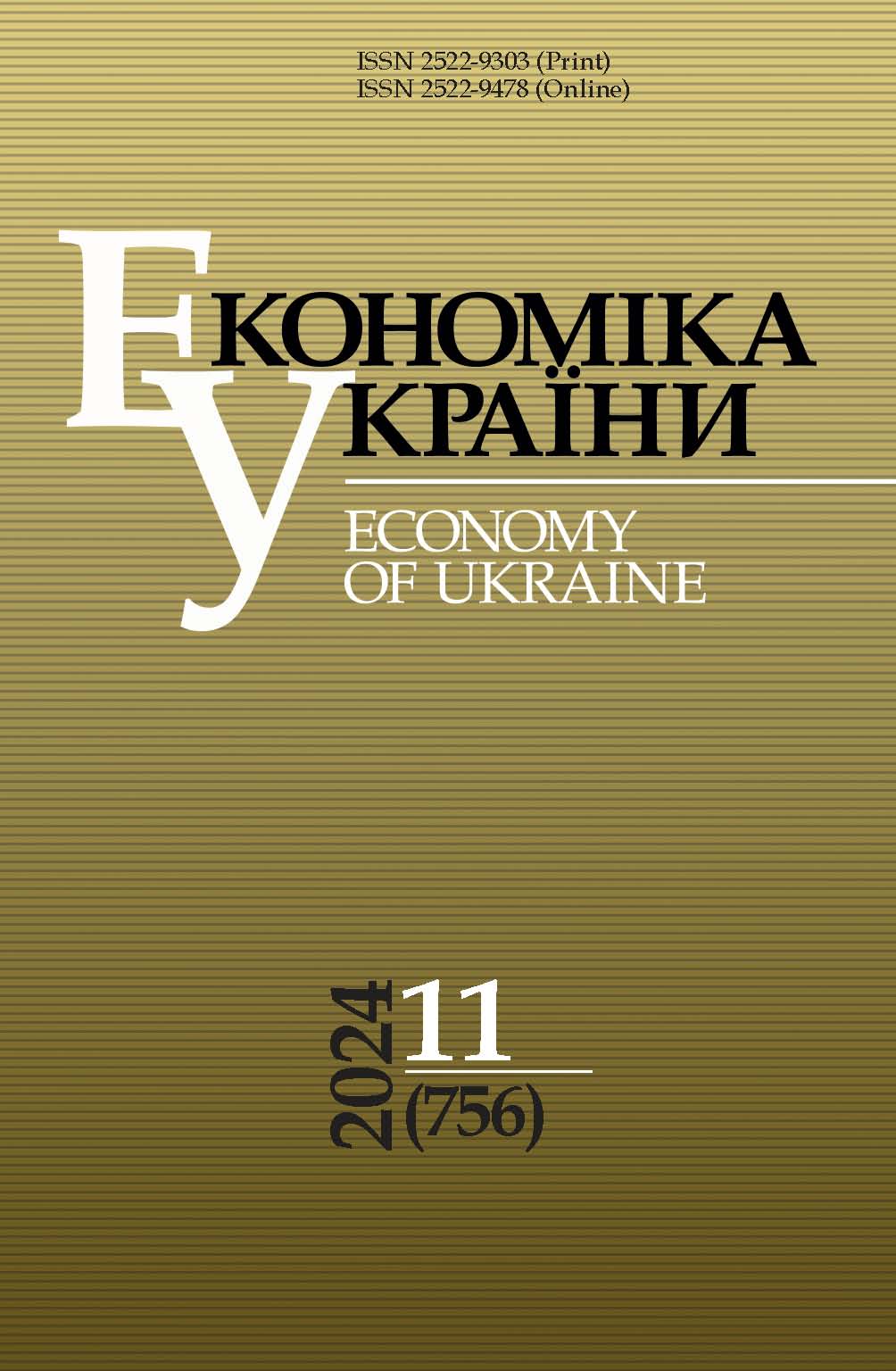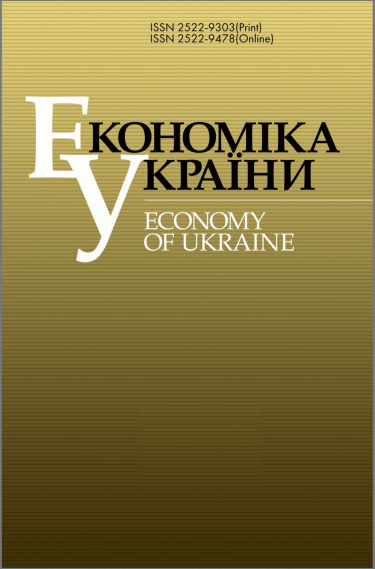ІНФЛЯЦІЙНЕ ТАРГЕТУВАННЯ В АЛЖИРІ: ПЕРЕШКОДИ І МОЖЛИВОСТІ
DOI:
https://doi.org/10.15407/economyukr.2024.11.029Ключові слова:
інфляційне таргетування; монетарна політика; правило Тейлора; узагальнений метод моментівАнотація
Проаналізовано доцільність інфляційного таргетування (IT) в Алжирі з використанням даних з І кварталу 2000 р. по IV квартал 2021 р. IT широко використовують, хоча його ефективність у регіонах, що розвиваються, зокрема на Близькому Сході й у Північній Африці, є спірною. Динаміку монетарної політики Алжиру і реакцію центрального банку на інфляцію та зміни виробництва досліджено за допомогою правила Тейлора і узагальненого методу моментів. Встановлено, що Банк Алжиру віддає перевагу згладжуванню відсоткових ставок перед короткостроковою економічною нестабільністю. Агресивна реакція центрального банку на відхилення цільових показників інфляції відповідає його очікуванням стабільності цін в умовах ІТ. Засвідчено меншу увагу до стабільності виробництва, можливо, через залежність економіки від нафти і негнучкість ринку праці. Показано, що монетарна політика Алжиру має елементи ІТ, проте її ефективність залежить від економічної ситуації та інституційної архітектури. Щоб глибше зрозуміти зусилля Алжиру з макроекономічної стабілізації, у майбутньому слід проаналізувати глобальну економічну ситуацію, волатильність цін на сировину, монетарну і фіскальну політику. Доповнено дискусію щодо корисності ІТ для економік, що розвиваються, підкреслено необхідність розгляду економічних умов та інституційних структур. Інфляційне таргетування може допомогти стабілізувати ціни в Алжирі, однак реалізувати цю модель монетарної політики в унікальних економічних умовах важко.
Посилання
Mishkin, F., Schmidt-Hebbel. K. (2007). Does inflation targeting make a difference? National Bureau of Economic Research Cambridge, Mass., USA. URL: http://www.nber.org/papers/w12876
Gertler, M., Bernanke, B. (1999). Monetary policy and asset price volatility. In: New Challenges for Monetary Policy. Jackson Hole Conference Proceedings. URL: https://nyuscholars.nyu.edu/en/publications/monetary-policy-and-asset-price-volatility
Woodford, M. (2003). Optimal interest-rate smoothing. The Review of Economic Studies, 70(4), 861-886. https://doi.org/10.1111/1467-937X.00270
Balima, W., Combes, J., Minea, A. (2017). Sovereign debt risk in emerging market economies: Does inflation targeting adoption make any difference? Journal of International Money and Finance, 70, 360-377. https://doi.org/10.1016/j.jimonfin.2016.10.005
Mishra, A., Dubey, A. (2022). Inflation targeting and its spillover effects on financial stability in emerging market economies. Journal of Policy Modeling, 44(6), 1198-1218. https://doi.org/10.1016/j.jpolmod.2022.10.003
Suh, S., Kim, D. (2021). Inflation targeting and expectation anchoring: Evidence from developed and emerging market economies. North American Journal of Economics and Finance, 58, 101535. https://doi.org/10.1016/j.najef.2021.101535
Hove, S., Tchana Tchana, F., Touna Mama, A. (2017). Do monetary, fiscal and financial institutions really matter for inflation targeting in emerging market economies? Research in International Business and Finance, 39, 128-149. https://doi.org/10.1016/j.ribaf.2016.07.025
Stojanovikj, M., Petrevski, G. (2021). Macroeconomic effects of inflation targeting in emerging market economies. Empirical Economics, 61(5), 2539-2585. https://doi.org/10.1007/s00181-020-01987-0
Ebeke, C., Fouejieu, A. (2018a). Inflation targeting and exchange rate regimes in emerging markets. The BE Journal of Macroeconomics, 18(2), 20170146. https://doi.org/10.1515/bejm-2017-0146
Chugunov, I., Pasichnyi, M., Nepytaliuk, A. (2019). Macroeconomic effects of inflation targeting in advanced and emerging market economies. Banks and Bank Systems, 14(4), 153-165. https://doi.org/10.21511/bbs.14(4).2019.15
Boucekkine, R., Laksaci, M., Touati-Tliba, M. (2021). Long-run stability of money demand and monetary policy: The case of Algeria. The Journal of Economic Asymmetries, 24, e00217. https://doi.org/10.1016/j.jeca.2021.e00217
Allegret, J. P., Benkhodja, M. T. (2015). External shocks and monetary policy in an oil exporting economy (Algeria). Journal of Policy Modeling, 37(4), 652-667. https://doi.org/10.1016/j.jpolmod.2015.03.017
Omolade, A., Ngalawa, H. (2016). Monetary policy transmission and growth of the manufacturing sector in Algeria. Investment Management and Financial Innovations, 13(4-1), 212-224. http://dx.doi.org/10.21511/imfi.13(4-1).2016.07
Roger, M., Stone, M. (2005). On target? The international experience with achieving inflation targets. IMF Working paper. August. URL: https://www.bookstore.imf.org/books/on-target-the-international-experience-with-achieving-inflation-targets
Ball, L., Sheridan, N. (2004). Does inflation targeting matter? In: The inflation-targeting debate. University of Chicago Press. P. 249-282. URL: http://www.nber.org/chapters/c9561
Hoffmann, M., Moench, E., Pavlova, L., Schultefrankenfeld, G. (2022). Would households understand average inflation targeting? Journal of Monetary Economics, 129, S52-S66. https://doi.org/10.1016/j.jmoneco.2022.02.006
Budianto, F., Nakata, T., Schmidt, S. (2023). Average inflation targeting and the interest rate lower bound. European Economic Review, 152, 104384. https://doi.org/10.1016/j.euroecorev.2023.104384
Apeti, A., Combes, J.-L., Minea, A. (2023b). Inflation targeting and the composition of public expenditure: Evidence from developing countries. Journal of Macroeconomics, 76, 103523. https://doi.org/10.1016/j.jmacro.2023.103523
Apeti, A., Combes, J.-L., Minea, A. (2023a). Inflation targeting and fiscal policy volatility: Evidence from developing countries. Journal of International Money and Finance, 102996. https://doi.org/10.1016/j.jimonfin.2023.102996
Jia, C., Wu, J. (2023). Average inflation targeting: Time inconsistency and ambiguous communication. Journal of Monetary Economics, 138, 69-86. https://doi.org/10.1016/j.jmoneco.2023.05.010
Herzog, B. (2023). How credible is average and symmetric inflation targeting in an episode of high inflation? Economic Analysis and Policy, 80, 1750-1761. https://doi.org/10.1016/j.eap.2023.11.007
Ebeke, C., Fouejieu, A. (2018b). Inflation targeting and exchange rate regimes in emerging markets. The BE Journal of Macroeconomics, 18(2). https://doi.org/10.1515/bejm-2017-0146
Cabral, R., Carneiro, F., Mollick, A. (2020). Inflation targeting and exchange rate volatility in emerging markets. Empirical Economics, 58(2), 605-626. https://doi.org/10.1007/s00181-018-1478-8
Šoškić, D. (2015). Inflation targeting challenges in emerging market countries: The case of Serbia. Economic Annals, 60(204), 7-30. https://doi.org/10.2298/EKA1504007S
Ravn, M., Uhlig, H. (2002). On adjusting the Hodrick-Prescott filter for the frequency of observations. Review of economics and statistics, 84(2), 371-376. https://doi.org/10.1162/003465302317411604
Taylor, J. (1993). Discretion versus policy rules in practice. Carnegie-Rochester conference series on public policy. Vol. 39. pp. 195-214. https://doi.org/10.1016/0167-2231(93)90009-L
Ajello, A., Laubach, T., Lopez-Salido, D., Nakata, T. (2016). Financial stability and optimal interest-rate policy. Federal Reserve Board. 72 p. URL: http://www.federalreserve.gov/econresdata/feds/2016/files/2016067pap.pdf
Reifschneider, D., Williams, J. C. (2000). Three lessons for monetary policy in a low-inflation era. Journal of Money, Credit and Banking, 936-966. https://doi.org/10.2307/2601151
Bianchi, F., Melosi, L., Rottner, M. (2021). Hitting the elusive inflation target. Journal of Monetary Economics, 124, 107-122. https://doi.org/10.1016/j.jmoneco.2021.10.003
Davig, T., Leeper, E., Walker, T. (2011). Inflation and the fiscal limit. European Economic Review, 55(1), 31-47. https://doi.org/10.1016/j.euroecorev.2010.11.005
Qin, T., Enders, W. (2008). In-sample and out-of-sample properties of linear and nonlinear Taylor rules. Journal of Macroeconomics, 30(1), 428-443. https://doi.org/10.1016/j.jmacro.2006.10.001
Clarida, R., Galı, J., Gertler, M. (1998). Monetary policy rules in practice: Some international evidence. European Economic Review, 42(6), 1033-1067. https://doi.org/10.1016/S0014-2921(98)00016-6
Clarida, R., Gali, J., Gertler, M. (2000). Monetary policy rules and macroeconomic stability: evidence and some theory. The Quarterly Journal of Economics, 115(1), 147-180. https://doi.org/10.1162/003355300554692
Ball, L. (1999). Policy rules for open economies. In: Monetary policy rules. University of Chicago Press. P. 127-156. URL: http://www.nber.org/books/tayl99-1
Ball, L. (2000). Policy rules and external shocks. In: National Bureau of Economic Research Cambridge, Mass., USA. https://doi.org/10.3386/w7910
Svensson, L. (2000). Open-economy inflation targeting. Journal of International Economics, 50(1), 155-183. https://doi.org/10.1016/S0022-1996(98)00078-6
Taylor, J. (2002). The monetary transmission mechanism and the evaluation of monetary policy rules. Banco Central de Chile. URL: https://hdl.handle.net/20.500.12580/3650
Djedaiet, A., Ayad, H., Ben-Salha, O. (2024). Oil prices and the load capacity factor in African oil-producing OPEC members: Modeling the symmetric and asymmetric effects. Resources Policy, 89, 104598. https://doi.org/10.1016/j.resourpol.2023.104598
Dickey, D., Fuller, W. (1981). Likelihood ratio statistics for autoregressive time series with a unit root. Econometrica: Journal of the Econometric Society, 1057-1072. https://doi.org/10.2307/1912517
Phillips, P., Perron, P. (1988). Testing for a unit root in time series regression. biometrika, 75(2), 335-346. https://doi.org/10.1093/biomet/75.2.335
Kwiatkowski, D., Phillips, P., Schmidt, P., Shin, Y. (1992). Testing the null hypothesis of stationarity against the alternative of a unit root: How sure are we that economic time series have a unit root? Journal of econometrics, 54(1-3), 159-178. https://doi.org/10.1016/0304-4076(92)90104-Y
Sargan, J. (1958). The estimation of economic relationships using instrumental variables. Econometrica: Journal of the Econometric Society, 393-415. https://doi.org/10.2307/1907619
##submission.downloads##
Опубліковано
Як цитувати
Номер
Розділ
Ліцензія
Авторське право (c) 2024 Видавничий дім "Академперіодика" НАН України

Ця робота ліцензується відповідно до Creative Commons Attribution-NonCommercial-NoDerivatives 4.0 International License.



